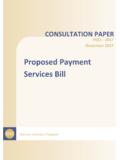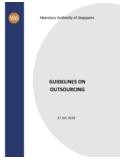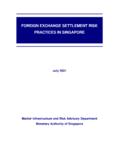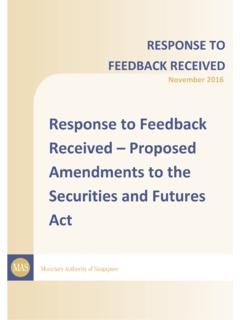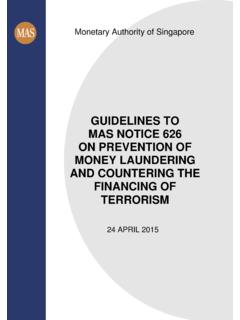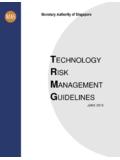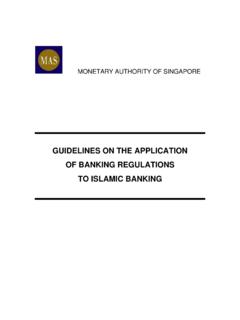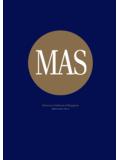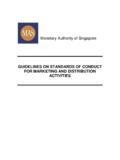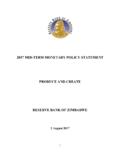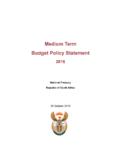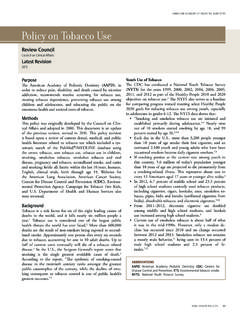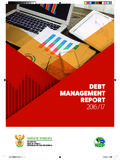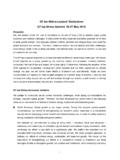Transcription of Volume XVI, Issue 1 April 2017 - Monetary Authority of ...
1 Volume XVI, Issue 1 April 2017 Volume XVI, Issue 1 April 2017 Economic policy Group Monetary Authority of Singapore ISSN 0219-8908 Published in April 2017 Economic policy Group Monetary Authority of Singapore All rights reserved. No part of this publication may be reproduced, stored in a retrieval system or transmitted in any form or by any means, electronic, mechanised, photocopying, recording or otherwise, without the prior written permission of the copyright owner except in accordance with the provisions of the Copyright Act (Cap. 63). Application for the copyright owner's written permission to reproduce any part of this publication should be addressed to: Economic policy Group Monetary Authority of Singapore 10 Shenton Way MAS Building Singapore 079117 Printed by Xpress Print Singapore Monetary Authority of Singapore Economic policy Group Contents Preface i Monetary policy Statement ii -iv 1 The International Economy 2 G3 Economies 3 Asia 9 Global Inflation 15 2 The Singapore Economy 18 Recent Economic Developments 19 Economic Outlook 25 Box A: The Opportunities For E-Commerce In The Retail Sector 30 3 Labour Market And Inflation 34 Labour Market 35 Consumer Price Developments 40 Box B: An Empirical Analysis Of Food Price Pass-through In Singapore 48 4 Macroeconomic policy 54 Monetary policy 55 Fiscal policy 62 Box C.
2 The Currency Interchangeability Agreement: Fifty Years On 73 Special Features Special Feature A: Optimal Control In The Monetary Model Of Singapore 78 Special Feature B: The Role Of Exchange Rates In International Price 8 5 Adjustment Special Feature C: Using Cost-Benefit Analysis In Developed And 9 2 Developing Countries: Is It The Same? Statistical Appendix 98 Macroeconomic Review, April 2017 Monetary Authority of Singapore Economic policy Group LIST OF ABBREVIATIONS 3 MMA three-month moving average ACU Asian Currency Unit AE advanced economies ASEAN Association of Southeast Asian Nations BOJ Bank of Japan CFE Committee on the Future Economy COE Certificate of Entitlement CPF Central Provident Fund CPI consumer price index DBU Domestic Banking Unit ECB European Central Bank EIA Energy Information Administration EPG Economic policy Group FI Fiscal Impulse FOMC Federal Open Market Committee GFC Global Financial Crisis GFCF gross fixed capital formation GOS gross operating surplus GST Goods and Services Tax ICT information and communications technology IMF International Monetary Fund IT information technology LIBOR London interbank offered rate MMS Monetary Model of Singapore MNC multinational corporation m-o-m month-on-month NEA Northeast
3 Asian economies NEER nominal effective exchange rate NODX Non-oil Domestic Exports OECD Organisation for Economic Cooperation and Development OPEC Organisation of the Petroleum Exporting Countries PBOC People s Bank of China PMET professionals, managers, executives and technicians PMI Purchasing Managers Index PPI producer price index q-o-q quarter-on-quarter REER real effective exchange rate SA seasonally adjusted SAAR seasonally adjusted annualised rate SIBOR Singapore interbank offered rate SME small and medium enterprise UBC unit business cost ULC unit labour cost WTO World Trade Organisation y-o-y year-on-year Preface i Monetary Authority of Singapore Economic policy Group Preface The Macroeconomic Review is published twice a year in conjunction with the release of the MAS Monetary policy Statement. The Review documents the Economic policy Group s (EPG) analysis and assessment of macroeconomic developments in the Singapore economy, and shares with market participants, analysts and the wider public, the basis for the policy decisions conveyed in the Monetary policy Statement.
4 It also features in-depth studies undertaken by EPG on important economic issues facing Singapore. To mark the 50th anniversary of the Currency Interchangeability Agreement between Singapore and Brunei Darussalam, EPG and the Autoriti Monetari Brunei Darussalam (AMBD) collaborated on a commemorative article. Box C presents a historical narrative of the currency arrangements in both territories that led to the Agreement, and explains why currency interchangeability has worked well for Singapore and Brunei. We would like to thank Mr Freddy Orchard for his comments on the article. Also in this Issue of the Review, Special Feature A presents the newly incorporated optimal control capability in EPG s flagship model, the Monetary Model of Singapore. As in past editions, we are pleased to highlight the research of visiting MAS Term Professors, and in this Issue we are grateful to Professor Charles Engel from the University of Wisconsin Madison for contributing Special Feature B on the role of exchange rates in international price adjustment.
5 Our appreciation goes to Professor Euston Quah of the Nanyang Technological University for Special Feature C, which examines the pitfalls of applying cost-benefit analysis to developing countries. Finally, we would like to thank Associate Professor Peter Wilson for editing the Review. The data used in the Review was drawn from the following government agencies, unless otherwise stated: BCA, CAAS, CPF Board, DOS, EDB, IE Singapore, LTA, MOF, MOM, MND, MPA, MTI, STB and URA. The Review can be accessed in PDF format on the MAS website: policy /Macroeconomic-Review. Hard copies of the Review may also be purchased at major bookstores or ordered online ( ). ii Macroeconomic Review, April 2017 Monetary Authority of Singapore Economic policy Group 13 April 2017 Monetary policy Statement INTRODUCTION 1. In the October 2016 Monetary policy Statement (MPS), MAS kept the slope of the Singapore dollar nominal effective exchange rate (S$NEER) policy band at zero percent, with no change to the width of the policy band or the level at which it was centred.
6 This policy stance was assessed to be appropriate given the subdued outlook for growth and inflation. Chart 1 S$ Nominal Effective Exchange Rate (S$NEER) 2. Following the October 2016 MPS, the S$NEER has fluctuated around a strengthening trend, appreciating from below the mid-point of the policy band to the upper half of the band. The appreciation from late February 2017 reflected, in part, broad-based US dollar weakness. Meanwhile, the three-month S$ SIBOR rose from as at end-October 2016 to by end-March 2017 . OUTLOOK 3. Over the last six months, the global economy has picked up and should continue to support Singapore s trade-related sectors. However, activity across the broader domestic economy is likely to be uneven, and overall GDP growth in 2017 will remain modest. MAS Core Inflation will rise from in 2016 to average 1 2% in 2017 due to increases in global oil prices, as well as the temporary effects of administrative price hikes.
7 Over the medium term, core inflation is expected to trend towards but average slightly below 2%. 98100102104106 AprJulOctJanAprJulOctJanAprJulOctJanAprJ ulOctJanAprIndex (1 5 Apr 2013 Average = 100)2013 AppreciationDepreciationindicates release of Monetary policy Statement2014201520162017 Monetary policy Statement iii Monetary Authority of Singapore Economic policy Group Growth 4. According to the Advance Estimates released by the Ministry of Trade and Industry today, the Singapore economy contracted by on a quarter-on-quarter seasonally-adjusted annualised basis in Q1 2017 , following the expansion in Q4 2016 when there was a temporary step-up in a number of externally-oriented industries, such as the biomedical cluster. Despite the pullback in the first quarter, the underlying momentum in the economy remains intact, with output of electronics and its related services segments still at healthy levels.
8 On a year-ago basis, overall GDP grew by in Q1 2017 . 5. The outlook for the global economy has improved slightly since the October 2016 MPS, although downside risks remain, alongside significant policy uncertainty. Global capital expenditure has begun to turn up amid some strengthening in business sentiment, while improving labour market conditions should sustain final demand in the developed economies. The outlook for China has stabilised on the back of firming corporate profitability and accommodative fiscal policy . 6. Against this external backdrop, activity in Singapore s trade-related sectors should support overall GDP growth in 2017 . The turnaround in the global IT cycle will continue to benefit the domestic semiconductor and precision engineering industries. However, the performance in the rest of the manufacturing sector will remain patchy.
9 The modern services cluster is expected to expand at a slightly faster pace in 2017 , led by a pickup in the financial sector and firm demand for ICT services. While healthcare and education services will be underpinned by resilient demand, spending on discretionary retail items and other services is expected to be dampened by the still-subdued labour market and weak consumer sentiment. Overall, the economy should expand by 1 3% in 2017 , not markedly different from the growth of 2% in 2016. Inflation 7. MAS Core Inflation, which excludes the costs of private road transport and accommodation, edged up to average year-on-year in January February 2017 , from in Q4 2016. After turning positive in late 2016, CPI-All Items inflation came in at in the first two months of this year, compared to an average of in Q4 last year. The increase in both core and headline inflation was largely due to higher prices of oil-related items, such as electricity and petrol, as global oil prices have risen from their 2016 trough.
10 8. In 2017 , energy-related components will be the main drivers of the projected pickup in inflation. While global oil prices would be capped by elevated inventories as well as rising US crude oil production, average prices for the year will still be higher than in 2016. A number of administrative price adjustments1 this year will also contribute to a temporary increase in CPI inflation. 9. Other domestic sources of inflation remain relatively muted, as conditions in the labour market have slackened since the last policy review. This will dampen underlying wage pressures, even as commercial and retail rents have eased further. The lacklustre economic environment will also limit the extent to which businesses pass on higher import and administrative costs to consumers. Meanwhile, 1 These include the upward revisions in car park charges and household refuse collection fees which took effect from December 2016 and January 2017 respectively, as well as upcoming increases in water prices and service & conservancy charges (S&CC).
